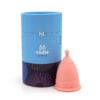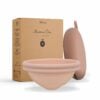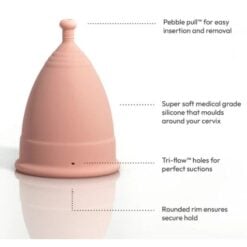_Faace, &Sisters / Nüdie Cup, Beauty News
Eco-conscious Menstrual Alternatives: Ways to Make Your Period More Planet-Friendly
Re-thinking Tampons
Women, on average, utilize approximately 14,000 tampons in their lifetimes. Add to this the alarming figure of 27,938 used tampons and applicators found on beaches globally each day, and it’s clear why many contemporary brands are developing innovative substitutes.
These alternative tampon solutions are transforming the menstrual care industry, not only from an eco-perspective but also by adding practicality points. Here are some options you might want to consider for a greener menstrual care update:
Menstrual Cups
If you’re a regular tampon user, you may want to give menstrual cups a try. Menstrual cups have become a convenience revolution, their popularity skyrocketing in recent years. Dr. Ruth Arumala informs us that they can be used for up to twelve hours, and they usually last around a year. Worried about leaks? Dr. Arumala assures us that most cups can comfortably manage the average daily blood volume, equivalent to a couple of teaspoons.
The eco-advantages are clear, but the reusable nature of menstrual cups also drastically reduces your period care expenses. According to Insider, a menstrual cup can reduce your menstrual cost by 90%.
Reusable Tampon Applicators
If you’re not quite prepared to entirely abandon your go-to tampons, swapping to a reusable applicator can still give you significant eco-credits. Plastic applicators, used worldwide, take five centuries to decompose, making their environmental footprint colossal.
Reusable applicators are user-friendly, compatible with all tampon sizes, and durable, with a lifespan of up to 3,000 uses.
Eco-Innovations
Given the current pollution crisis, numerous female-led initiatives are striving to develop more eco-friendly tampons. From biodegradable packaging and tampons to recyclable delivery boxes and convenient subscription services, the eco-conscious menstrual care market is set to expand.
Pad Alternatives
Traditional period pads consist of up to 90% plastic. Considering a woman uses an average of 11,000 disposable pads in her lifetime, pads rank fifth on the list of common single-use plastics on European beaches. Women worldwide are shifting from these major period pollution contributors to their eco-friendly substitutes.
Period Underwear
Period underwear is one of the top sustainable menstrual alternatives, growing rapidly in popularity. Many mainstream UK brands now carry these leak-resistant products, which typically hold up to two tampons’ worth of blood. The CEO of eco-friendly period care brand Wuka tells British Vogue, “To date, we have saved more than 30 million pads and tampons from entering landfills.”
Reusable Pads
Reusable sanitary pads, typically composed of layered flannel and super-absorbent cotton, are machine-washable and often more absorbent than disposable versions. Many women resort to these pads to boost their eco-efforts. Some brands offer options wearable for up to eight hours, surpassing the average pad’s duration.
Green Bonus Points
Although your actual period products play the most substantial role in transitioning to a more eco-friendly routine, considering the environmental impact of your cycle-related beauty and wellness practices can further bolster your planet-friendly pledge.
Whether it’s embracing more sustainable skincare or exploring innovative pain management options like CBD tampons, even the self-care aspects of our periods can be enhanced with eco-conscious alternatives.























 Beauty Products
Beauty Products By Skintype
By Skintype Brands A-Z
Brands A-Z Wellness
Wellness Health / Nutrition
Health / Nutrition